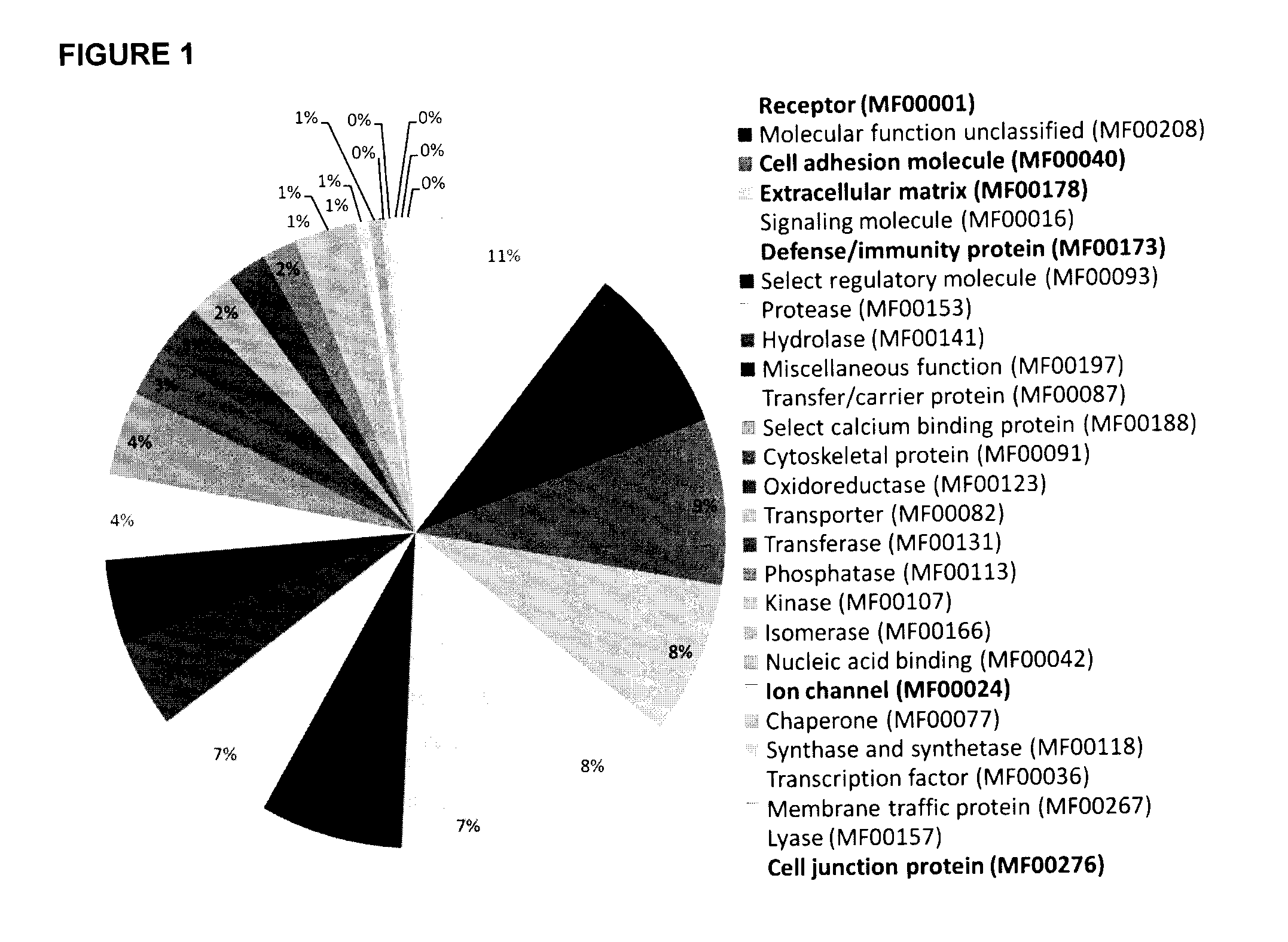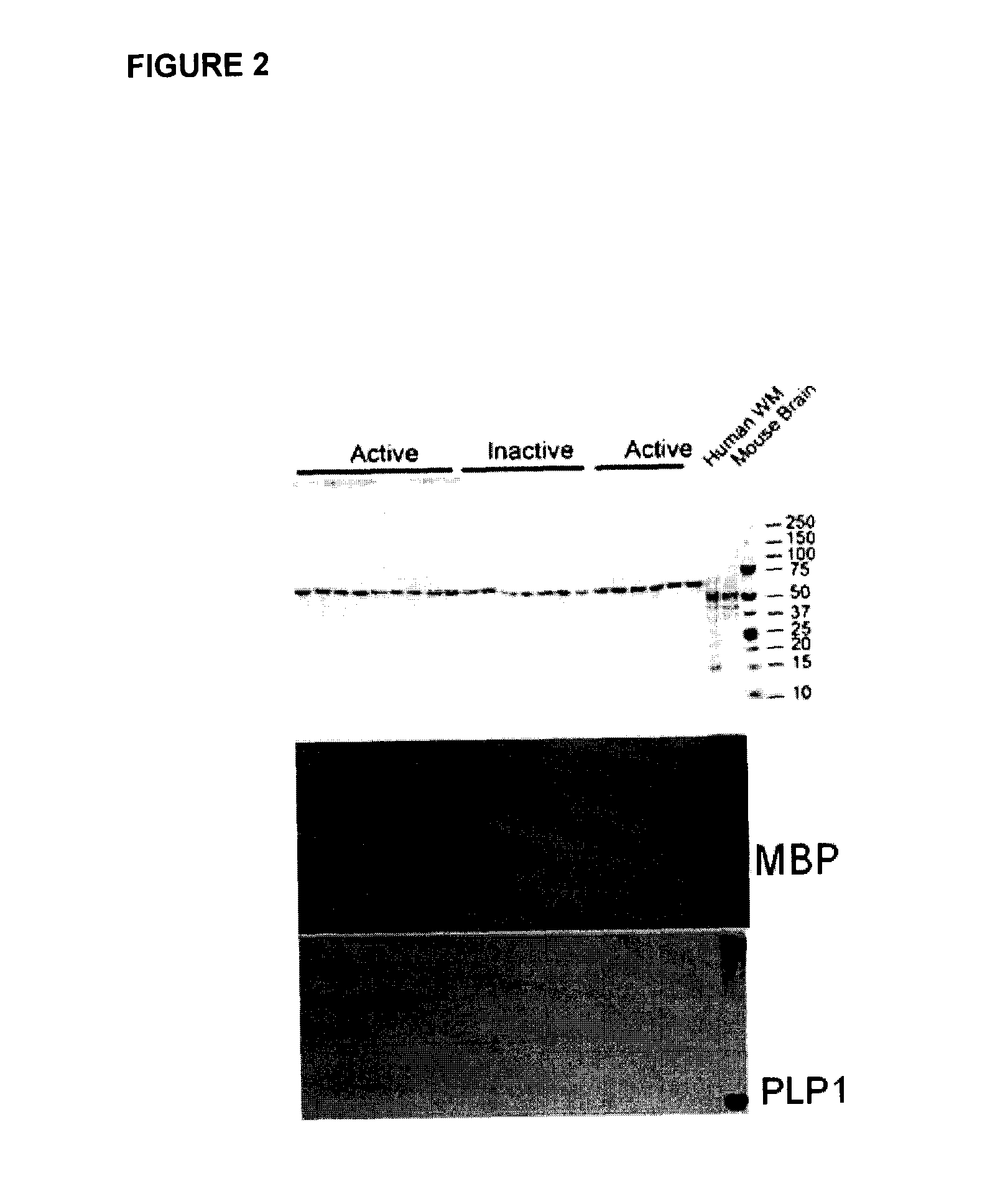Biomarkers for multiple sclerosis
a biomarker and multiple sclerosis technology, applied in the field of multiple sclerosis biomarkers, can solve the problems of inability to distinguish between pediatric ms and other childhood cns inflammatory demyelinating disorders, unpredictable physical or cognitive disability, and large variability of ms
- Summary
- Abstract
- Description
- Claims
- Application Information
AI Technical Summary
Benefits of technology
Problems solved by technology
Method used
Image
Examples
example 1
Detection of Nodal Proteins and not Compact Myelin Proteins in the CSF
[0063]Injury to the CNS compact myelin is often associated with auto-antibodies to compact myelin proteins (proteolipid protein (PLP), myelin basic protein (MBP), 2′,3′-cyclic nucleotide 3′-phosphodiesterase (CNP)) in MS patients. The reason for synthesis and secretion of auto-antibodies directed against several myelin antigens in serum and CSF of MS patients remains unknown. In order to investigate whether these auto-antibodies are synthesized and secreted as a result of injury to the myelin sheath, resulting in CSF leakage of antigens, immunoblotting was used to look for myelin antigen in CSF obtained from children during the first episode of CNS demyelination. In humans, PLP1 and MBP together constitute about 75-90% of myelin protein content. However, no sign of PLP1, MBP or CNPase leakage into the CSF samples was identified (FIG. 2, wherein antibodies for two independent non-overlapping epitopes were used, and...
example 2
Proteomic Analysis
[0065]In order to identify biological protein markers in biofluids differentiating active (at high risk of developing MS or having MS) vs. inactive (at low risk) children presenting with clinically isolated syndrome (CIS) or acquired demyelination syndrome (ADS), proteomic analysis of biofluids from 24 children presenting with CIS / ADS (of which 19 samples were analyzed) was performed. A label-free differential proteomic analysis from PPD Biomarker Discovery Sciences (Menlo Park, Calif.) was performed using liquid chromatography-mass spectrometry (LC-MS). A one-dimensional chromatography cerebral spinal fluid (CSF) and two-dimensional chromatography serum proteomic analysis were performed. For each of these biofluids, 14 abundant proteins were depleted by an antibody column prior to digestion by trypsin. Hundreds of proteins were tracked in each of the two analyses.
[0066]CSF and serum samples were collected from children participating in the Canadian prospective stu...
example 3
Detection of Axoglial-Apparatus Auto-Antigens in the CSF
[0075]In addition to their insulating function in the CNS, oligodendrocytes also trigger domain formation on axonal membranes, resulting in the nodal, paranodal and juxtaparanodal specializations of the axonal membrane. These axonal specializations together with the overlying and attached glial paranodal loops are known as the axoglial-apparatus (Pedraza, L., Huang, J. K. & Colman, DR., Neuron 30, 335-344 (2001); Huang, J. K., et al. Science 310, 1813-1817 (2005)).
[0076]Very little is known about the formation and assembly of the axoglial-apparatus in the CNS, however several key molecules exclusively localized to these areas have been identified. Table 5 summarizes known axoglial-apparatus proteins that are known to mediate axon-glia interaction in maintaining the integrity of the functional node of Ranvier. Table 5 also summarizes various molecules that mediate axon-glia interaction along the internode and which might indirec...
PUM
 Login to View More
Login to View More Abstract
Description
Claims
Application Information
 Login to View More
Login to View More - R&D
- Intellectual Property
- Life Sciences
- Materials
- Tech Scout
- Unparalleled Data Quality
- Higher Quality Content
- 60% Fewer Hallucinations
Browse by: Latest US Patents, China's latest patents, Technical Efficacy Thesaurus, Application Domain, Technology Topic, Popular Technical Reports.
© 2025 PatSnap. All rights reserved.Legal|Privacy policy|Modern Slavery Act Transparency Statement|Sitemap|About US| Contact US: help@patsnap.com



